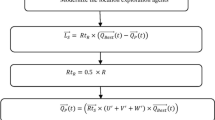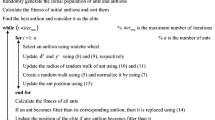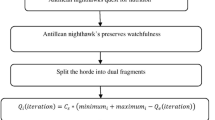Abstract
In this paper, Chaotic implanted opposition-based-quantum equipoise state (CIOQES) and Ascidiacea (CIOQAA) algorithms are applied to solve the loss diminishing problem. In the projected process, the swapping of capricious data is done with the illogical statistics stimulated by Laplace distribution to augment the aid of the possibility of creation level inside the exploration area. Opposition-based learning is one of the persuasive methods to enhance the convergence swiftness of methods. The prospering application of the opposition-based learning involves appraisal of opposite populace and prevailing populace in the parallel generation to determine the greater entrant elucidation. Quantum mechanics has been combined with the algorithms to emulate the analogous performance with the certain stage as they route in a credible powdered of median. Chaotic sequences are integrated into algorithms to augment the exploration and exploitation. Tinkerbell chaotic map engendering standards are implemented. Chaotic implanted opposition-based-quantum equipoise state (CIOQES) algorithm is based on the idea of quantum mechanics about the quantity, inbound, exodus, and fabrication in the governor capacity. Equipoise state algorithm possesses elements as entrant elucidation, and element’s location is designated as deliberation. Every element’s aptness function is calculated to define the equipoise state of populaces for picking the preeminent solution. Chaotic implanted opposition-based-quantum Ascidiacea (CIOQAA) algorithm is designed to solve the problem. Probing attitudes of Ascidiacea for nutrition spring is imitated to formulate Ascidiacea algorithm. Single end of the Ascidiacea body is continuously resolutely attached to surface like rock or coral. Ascidiacea bottom is corrugated, and core-like postponements will clutch the shallow. Proposed chaotic implanted opposition based-quantum equipoise state (CIOQES) and Ascidiacea (CIOQAA) algorithms are corroborated in G01–G24 benchmark functions, IEEE 30, 57, 118, 300 and 354 bus test systems. Diminished power loss, curtailed power discrepancy, and increased power constancy have been achieved.
















Similar content being viewed by others
Explore related subjects
Discover the latest articles, news and stories from top researchers in related subjects.Data Availability
No data available.
References
Ahmadnia S, Tafehi E, Dastgahian F (2019) Optimal placement and sizing for solar farm with economic evaluation, power line loss and energy consumption reduction. IETE J Res. https://doi.org/10.1080/03772063.2019.1694450
Azimi M, Mohammadi-ivatloo B, Zare K, Abapour M (2015) probabilistic allocation of Thyristor-controlled phase shifting transformer for transient stability enhancement of electric power system. IETE J Res 61:1–10. https://doi.org/10.1080/03772063.2015.1023743
Bentouati B, Khelifi A, Shaheen AM et al (2021) An enhanced moth-swarm algorithm for efficient energy management based multi dimensions OPF problem. J Ambient Intell Human Comput 12:9499–9519. https://doi.org/10.1007/s12652-020-02692-7
Bingane C, Anjos MF, Le Digabel S (2019) Tight-and-cheap conic relaxation for the optimal reactive power dispatch problem. IEEE Trans Power Syst 34(6):4684–4693
Bouwmeester D, Zeilinger A (2000) The physics of quantum information: basic concepts. In: the physics of quantum information. Berlin: Springer
Chen G, Liu L, Guo Y (2016) Shanwai Huang, Multi-objective enhanced PSO algorithm for optimizing power losses and voltage deviation in power systems. COMPEL Int J Comput Math Electr Electr Eng 35(1):350–372
Choi V (2018) Minor-embedding in adiabatic quantum computation I. The parameter setting problem. Quant Inf Process 7:193–209
Dai C, Chen W, Zhu Y, Zhang X (2009) Seeker optimization algorithm for optimal reactive power dispatch. IEEE T Power Syst 24(3):1218–1231
Darvish Falehi A (2020) Optimal robust disturbance observer based sliding mode controller using multi-objective grasshopper optimization algorithm to enhance power system stability. J Ambient Intell Human Comput 11:5045–5063. https://doi.org/10.1007/s12652-020-01811-8
Davoodi E, Babaei E, Mohammadi-Ivatloo B, Rasouli M (2019) A novel fast semidefinite programming-based approach for optimal reactive power dispatch. IEEE Trans Industr Inf 16(1):288–298
Diab H, Abdelsalam M, Abdelbary A (2021) A multi-objective optimal power flow control of electrical transmission networks using intelligent meta-heuristic optimization techniques. Sustainability 13:4979
Dinkar S, Deep K (2017) Opposition based Laplacian ant lion optimizer. J Comput Sci. https://doi.org/10.1016/j.jocs.2017.10.007
Duong TL, Duong MQ, Phan VD, Nguyen TT (2020) Optimal reactive power flow for large-scale power systems using an effective metaheuristic algorithm. Hindawi J Electr Comput Eng. https://doi.org/10.1155/2020/6382507
Ebeed M, Alhejji A, Kamel S, Jurado F (2020) Solving the optimal reactive power dispatch using marine predators algorithm considering the uncertainties in load and wind-solar generation systems. Energies 13(17):4316
Grudinin N (1998) Reactive power optimization using successive quadratic programming method. IEEE Trans Power Syst 13(4):1219–1225. https://doi.org/10.1109/59.736232
Hussain AN, Abdullah AA, Neda OM (2018) Modified particle swarm optimization for solution of reactive power dispatch. Res J Appl Sci Eng Technol 15(8):316–327. https://doi.org/10.19026/rjaset.15.5917
Illinois Center for a Smarter Electric Grid (ICSEG). Available online: https://icseg.iti.illinois.edu/ieee-30-bussystem/ (accessed on 25 February 2019)
Inoue (2000) Application of chaos degree to some dynamical systems Chaos, Solutions Fractals, 11 (1), 1377–1385
Jan R-M, Chen N (1995) Application of the fast Newton-Raphson economic dispatch and reactive power/voltage dispatch by sensitivity factors to optimal power flow. IEEE Trans Energy Convers 10(2):293–301
Joaquin D, Salvador G, Daniel M, Francisco H (2011) A practical tutorial on the use of nonparametric statistical tests as a methodology for comparing evolutionary and swarm intelligence algorithms. Swarm Evol Comput 1(1):3–18
Juneja K (2020) A fuzzy-controlled differential evolution integrated static synchronous series compensator to enhance power system stability. IETE J Res. https://doi.org/10.1080/03772063.2020.1795936
Karthik N, Parvathy AK, Arul R (2020) Multi-objective optimal reactive power dispatch using levy interior search algorithm. Int J Electr Eng Inf 12:547–570. https://doi.org/10.15676/ijeei.2020.12.3.8
Kazmi SA, Shahzad M, Shin D (2017) Voltage stability index for distribution network connected in loop configuration. IETE J Res 63:1–13. https://doi.org/10.1080/03772063.2016.1257376
Khazali H, Kalantar M (2011a) Optimal reactive power dispatch based on harmony search algorithm. Int J Electr Power Energy Syst 33(3):684–692
Khazali AH, Kalantar M (2011b) Optimal reactive power dispatch based on harmony search algorithm. Int J Electr Power Energy Syst 33:684–692
Khunkitti S, Siritaratiwat A, Premrudeepreechacharn S (2021) Multi-objective optimal power flow problems based on slime mould algorithm. Sustainability 13:7448. https://doi.org/10.3390/su13137448
Kien LC, Hien CT, Nguyen TT (2021) Optimal reactive power generation for transmission power systems considering discrete values of capacitors and tap changers. Appl Sci 11(12):5378. https://doi.org/10.3390/app11125378
Lakshmi Priya J, Jaya Christa ST (2021) An effective hybridized GWO-BSA for resolving optimal power flow problem with the inclusion of unified power flow controller. IETE J Res. https://doi.org/10.1080/03772063.2021.1942245
X Liu and X Liu (2013) Quantum-inspired genetic algorithm based on phase encoding. In: 2013 ninth international conference on natural computation (ICNC), 2013, pp. 444-448, doi: https://doi.org/10.1109/ICNC.2013.6818017
Luo S (2008) Quantum discord for two-qubit systems. Phys Rev A 77:042303
Lv F, Han M (2019) Hyperspectral image classification based on multiple reduced kernel extreme learning machine. Int J Mach Learn Cybern 10:3397–3405
Mandal B, Roy PK (2013) Optimal reactive power dispatch using quasi-oppositional teaching learning based optimization. Int J Electr Power Energy Syst 53:123–134
Mei RNS, Sulaiman MH, Mustaffa Z, Daniyal H (2017) Optimal reactive power dispatch solution by loss minimization using moth-flame optimization technique. Appl Soft Comput 59:210–222
Menon P, Rani B, Kumar K, Gupta V (2021) An effective OS–DPLL design for reducing power dissipation in an IoT application. J Ambient Intell Humaniz Comput. https://doi.org/10.1007/s12652-021-03016-z
Mouassa S, Bouktir T (2018) Multi-objective ant lion optimization algorithm to solve large-scale multi-objective optimal reactive power dispatch problem. COMPEL Int J Comput Math Electr Electr Eng 35(1):350–372
Mouassa S, Bouktir T, Salhi A (2017) Ant lion optimizer for solving optimal reactive power dispatch problem in power systems. Eng Sci Technol Int J 20(3):885–895
Nuaekaew K, Artrit P, Pholdee N, Bureerat S (2017) Optimal reactive power dispatch problem using a two-archive multi-objective grey wolf optimizer. Expert Syst Appl 87:79–89
Omelchenko IN & Lyakhovich D & Aleksandrov AA & Vodchits A & Kunkov NV (2020a) Development of a design algorithm for the logistics system of product distribution of the mechanical engineering enterprise. Herald of the Bauman Moscow State Technical University. Series Mechanical Engineering. pp. 62–69
Omelchenko I & Zakharov M & Lyakhovich D & Vodchits A (2020b) organization of logistic systems of scientific productions: scientific research work of the master's student and evaluation of its results. Doi: https://doi.org/10.18334/9785912923258.252-256
Omelchenko I & Lyakhovich D & Alexandrov A & Vodchits A & Sturua K (2020c) Problems and organizational and technical solutions of processing management problems of material and technical resources in a design-oriented organization. Doi: https://doi.org/10.18334/9785912923258.257-260
Pandya, S. and R. Roy, 2015. Particle swarm optimization based optimal reactive power dispatch. In: proceeding of the IEEE international conference on electrical, computer and communication technologies (ICECCT), pp: 1–5
Polprasert J, Ongsakul W, Dieu VN (2016) Optimal reactive power dispatch using improved pseudo-gradient search particle swarm optimization. Electr Power Compon Syst 44(5):518–532
PSTCA, Power Systems Test Case Archive, University of Washington, Available: http://www.ee.washington.edu/research/pstca/, 2016
Quintana VH, Santos-Nieto M (1989) Reactive-power dispatch by successive quadratic programming. IEEE Trans Energy Convers 4(3):425–435
Raghuwanshi BS, Shukla S (2019) Class imbalance learning using UnderBagging based kernelized extreme learning machine. Neurocomputing 329:172–187
Reddy SS (2014) Faster evolutionary algorithm based optimal power flow using incremental variables. Electr Power Energy Syst 54:198–210
Reddy SS (2017) Optimal reactive power scheduling using cuckoo search algorithm. Int J Electr Comput Eng 7(5):2349–2356
Roy R, Das T, Mandal KK (2021) Optimal reactive power dispatch using a novel optimization algorithm. J Electr Syst Inf Technol 8:18. https://doi.org/10.1186/s43067-021-00041-y
Sahli Z, Hamouda A, Bekrar A, Trentesaux D (2018) Reactive power dispatch optimization with voltage profile improvement using an efficient hybrid algorithm. Energies 11(8):2134
Sahli Z, Hamouda A, Bekrar A, and Trentesaux D, (2014) Hybrid PSO-tabu search for the optimal reactive power dispatch problem. In proceedings of the IECON 2014-40th annual conference of the IEEE industrial electronics society, Dallas, TX, USA, November 2014
Sambaiah KS, Jayabarathi T (2020) Optimal modeling and allocation of mixed wind and solar generation systems in electric distribution networks. IETE J Res. https://doi.org/10.1080/03772063.2020.1787876
Saravanan C, Anbalagan P (2021) Multi objective dragonfly algorithm for congestion management in deregulated power systems. J Ambient Intell Human Comput 12:7519–7528. https://doi.org/10.1007/s12652-020-02440-x
Saxena NK, Kumar A, Gupta V (2021) Enhancement of system performance using STATCOM as dynamic compensator with squirrel cage induction generator (SCIG) based microgrid. Int J Emerg Electr Power Syst 22(2):177–189. https://doi.org/10.1515/ijeeps-2020-0228
Schuld M, Killoran N (2019) Quantum machine learning in feature hilbert spaces. Phys Rev Lett 122:040504. https://doi.org/10.1103/PhysRevLett.122.040504
Sharma S, Ghosh S (2020) FIS and hybrid ABC-PSO based optimal capacitor placement and sizing for radial distribution networks. J Ambient Intell Human Comput 11:901–916. https://doi.org/10.1007/s12652-019-01216-2
Sridhar N, Kowsalya M (2021) Enhancement of power management in micro grid system using adaptive ALO technique. J Ambient Intell Human Comput 12:2163–2182. https://doi.org/10.1007/s12652-020-02313-3
Suash GG, Gandomi AH, Alavi AH (2016) Opposition-based krill herd algorithm with Cauchy mutation and position clamping. J Neurocomput 177:147–157. https://doi.org/10.1016/j.neucom.2015.11.018
Subbaraj P, Rajnarayan PN (2009) Optimal reactive power dispatch using self-adaptive real coded Genetic algorithm. Electr Power Syst Res 79(2):374–438
Suja KR (2021) Mitigation of power quality issues in smart grid using levy flight based moth flame optimization algorithm. J Ambient Intell Human Comput 12:9209–9228. https://doi.org/10.1007/s12652-020-02626-3
Terra LDB, Short MJ (1991) Security-constrained reactive power dispatch. IEEE Trans Power Syst 6(1):109–117
The IEEE 118-Bus Test System [online], available at http://www.ee.washington.edu/research/pstca/pf118/pg_tca118bus.htm
The IEEE 57-Bus Test System [online], available at http://www.ee.washington.edu/research/pstca/pf57/pg_tca57bus.htm
Tizhoosh HR. Opposition-based learning: a new scheme for machinei ntelligence. In: proceeding of the international conference on computational intelligence for modeling, control and automation, Austria. p. 695–701
Tran HV, Pham TV, Pham LH, Le NT, Nguyen TT (2019) Finding optimal reactive power dispatch solutions by using a novel improved stochastic fractal search optimization algorithm. Telecommun Comput Electr Control 17(5):2517–2526
Tudose A, Picioroaga I, Sidea D, Bulac C (2021) Solving single- and multi-objective optimal reactive power dispatch problems using an improved salp swarm algorithm. Energies 14:1222. https://doi.org/10.3390/en14051222
Vishnu M (2020) An improved solution for reactive power dispatch problem using diversity-enhanced particle swarm optimization. Energies. https://doi.org/10.3390/en13112862
Yu X, Feng Y, Gao Y, Jia Y, Mei S (2021) Dual-weighted kernel extreme learning machine for hyperspectral imagery classification. Remote Sensing 13(3):508. https://doi.org/10.3390/rs13030508
Zaidan MR, Toos SI (2021) Optimal location of static var compensator to regulate voltage in power system. IETE J Res. https://doi.org/10.1080/03772063.2021.1886877
Zhu JZ, Xiong XF (2003) Optimal reactive power control using modified interior point method. Electr Power Syst Res 66(2):187–192
Zou Q, Li A, He X, Wang X (2018) Optimal operation of cascade hydropower stations based on chaos cultural sine cosine algorithm. IOP Conference Series: Materials Science and Engineering, vol. 366 (1), IOP Publishing
Funding
No funding obtained.
Author information
Authors and Affiliations
Contributions
Single author—yes; Conception or design of the work—yes; Data collection—yes; Data analysis and interpretation—yes; Drafting the article—yes; Critical revision of the article—yes; Final approval of the version to be published—yes.
Corresponding author
Ethics declarations
Conflict of interest
No conflict of interest to declare.
Ethical approval
All the ethics are followed and no humans and animals are involved in the research.
Informed consent
Single author- And the author has full consent to submit the paper for possible publication.
Additional information
Publisher's Note
Springer Nature remains neutral with regard to jurisdictional claims in published maps and institutional affiliations.
Rights and permissions
About this article
Cite this article
Kanagasabai, L. Chaotic implanted opposition-based-quantum equipoise state and Ascidiacea algorithms for loss lessening and power permanence enrichment. Soft Comput 26, 8183–8202 (2022). https://doi.org/10.1007/s00500-022-07232-3
Accepted:
Published:
Issue Date:
DOI: https://doi.org/10.1007/s00500-022-07232-3




